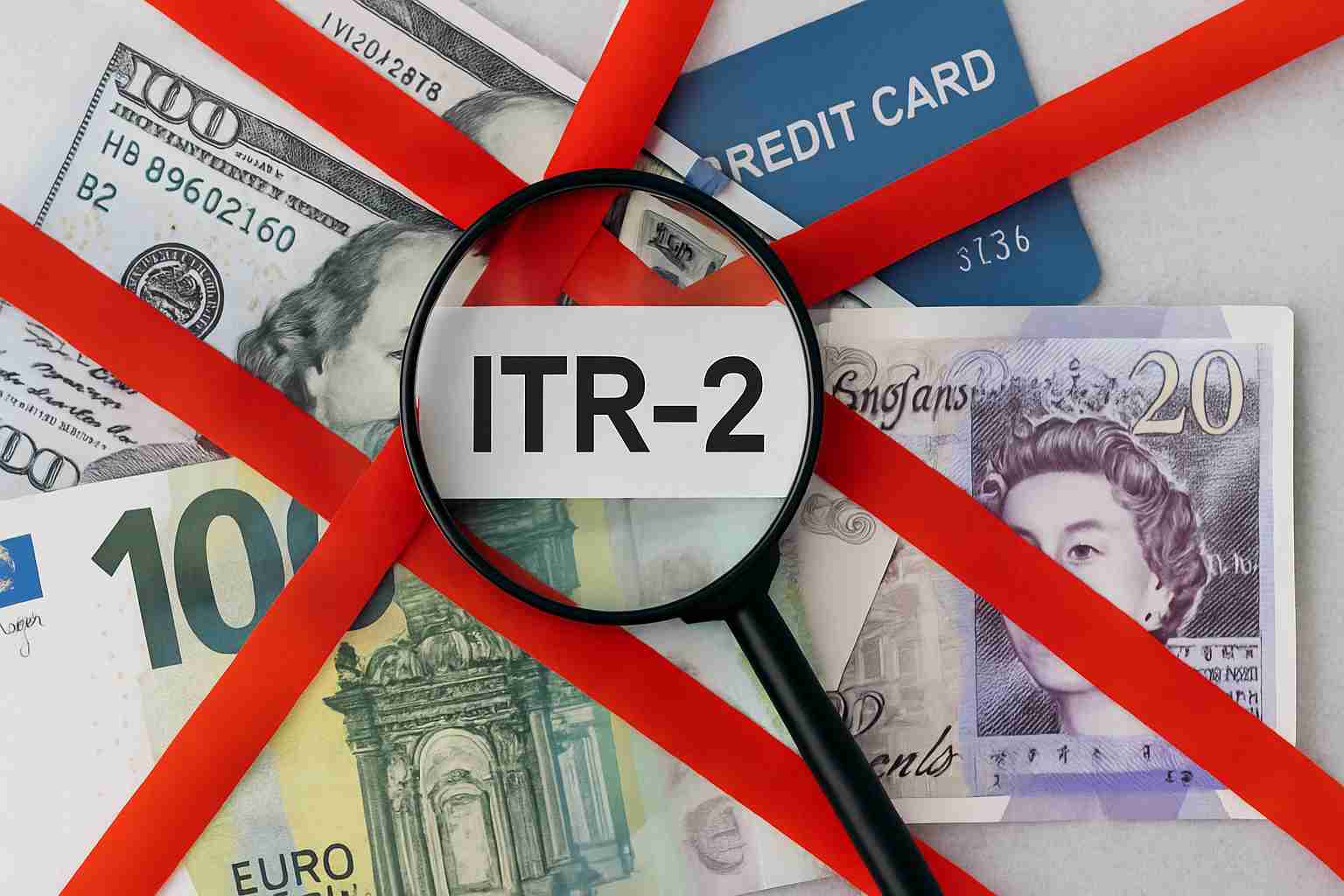Maybe you’ve just returned from a work stint abroad. Perhaps you’ve invested in US stocks, or a relative overseas gifted you some money. The excitement of new opportunities often comes with a common question that can cause a lot of anxiety: “How do I handle all this in my Income Tax Return (ITR)?”
Navigating ITR filing for foreign income and assets can feel like stepping into a minefield of complex rules and intimidating jargon. The worry of making a mistake is real, and the thought of facing a penalty can be stressful. But what if it didn’t have to be? This article is designed to cut through the confusion and give you a clear, simple roadmap. We’ll walk you through every step, helping you understand the rules and giving you the tools to file correctly, so you can stop worrying about penalties and start enjoying the confidence and relief of being completely compliant with tax regulations.
The First Step: Understanding Why You Need to Report
Before we dive into the “how,” it’s crucial to understand the “why.” This isn’t about complexity for the sake of it—it’s about a fundamental principle of Indian tax law that applies to all residents. Getting this first step right is the foundation for a seamless filing process.
Deciphering Your Tax Residency Status: ROR vs. RNOR
The single most important factor determining how you report your foreign finances is your tax residency status. In India, there are two statuses that apply to people with foreign ties:
- Resident and Ordinarily Resident (ROR): As an ROR, you are liable to pay tax on your worldwide income, encompassing earnings from both India and foreign sources. This includes your salary from a foreign employer, rental income from a property overseas, and any dividends or interest from foreign investments.
- Resident but Not Ordinarily Resident (RNOR) or Non-Resident (NR): If you fall into these categories, only the income you earn in India is taxable. Income earned and received outside India is not part of your taxable income in India.
For most individuals with foreign income and assets who have returned to India for good, the ROR status is the one to pay attention to. Think of it this way: once you are an ROR, the Income Tax Department considers the entire world your backyard for tax purposes.
The High Cost of Non-Compliance: Understanding the Black Money Act
This is not meant to scare you, but to inform you of the seriousness of non-disclosure. The Indian government is very strict about citizens with foreign finances. If you are an ROR and do not disclose your foreign assets in your ITR, you can face severe consequences under the Black Money (Undisclosed Foreign Income and Assets) and Imposition of Tax Act, 2015, widely referred to as the Black Money Law.
The penalty for failing to disclose a foreign asset is a steep ₹10 lakh per year for each undisclosed asset. This is not a small penalty; it’s a significant sum intended to ensure rigorous adherence to regulations. Knowing this upfront is the first step toward avoiding it completely. The goal isn’t to be afraid of the rules, but to use them to your advantage by filing accurately and on time.
Choosing the Right Form: Your Filing Blueprint

A common mistake Indian taxpayers make when they get their first foreign income or asset is trying to file with the wrong form. They might assume their tax situation is simple and just go for ITR-1, the most popular form. But once foreign elements are involved, ITR-1 is instantly out of the question. Your journey with ITR filing for foreign income and assets must begin with either ITR-2 or ITR-3.
A Simple Checklist to Choose Your Form
Choosing between ITR-2 and ITR-3 is surprisingly straightforward. The primary deciding factor is whether you have any “Profits or Gains from Business or Profession.” Here’s a simple checklist to help you decide:
Go for ITR-2 if you have:
- Salary or pension income from India or abroad.
- Income from one or more house properties.
- Capital gains from the sale of shares (Indian or foreign), mutual funds, or property.
- Earnings from other avenues, including interest, dividends, or lottery prizes.
- Foreign assets (like a bank account, property, or investments) that need to be declared.
- The status of Resident but Not Ordinarily Resident (RNOR) or Non-Resident.
Crucially, ITR-2 is for you only if you do not have any income from a business or profession. If you tick any of the boxes above and have no business income, ITR-2 is your form.
Go for ITR-3 if you have:
- Any and all of the income sources listed for ITR-2.
- PLUS income from a business or profession.
What if I Have Business Income and Foreign Assets?
This is where the distinction is vital. Let’s consider a few real-life scenarios that many Indian residents find themselves in:
- You’re an IT professional with a side hustle. You have your regular salary (income from salary) and a foreign bank account, but you also do some freelance consulting on weekends. That freelancing income is considered “profits or gains from business or profession.” In this case, you must file ITR-3.
- You’re a retired professional with foreign assets. You receive a pension (salary income) and have some foreign stocks. After retirement, you start a small consulting service. Even though your foreign investments and pension would allow you to file ITR-2, the income from your consulting business makes ITR-3 the only valid choice.
- You trade stocks. If you are an active intraday trader or trade in Futures & Options (F&O), the income from this is often considered business income. Even if your only other income is from your salary and foreign investments, you’ll need to use ITR-3.
The key takeaway is this: the moment a part of your income is from a business, profession, or freelancing, your filing automatically shifts from ITR-2 to ITR-3. Using ITR-2 in this situation will lead to a defective return and potential notices from the tax department.
Detailed Breakdown of Foreign Assets and Income

Now that you’ve determined the correct form, it’s time to gather the specifics. The Indian tax authorities require you to be transparent and detailed about all your foreign holdings, not just the ones that generated income. This is a common point of confusion—many believe that if an account is dormant or an investment hasn’t matured, it doesn’t need to be reported. That’s incorrect. The law is clear: if you are an ROR, you must disclose all foreign assets, regardless of whether they yielded any income.
Foreign Bank Accounts and Deposits
This is among the most frequently encountered categories of foreign assets. The Income Tax Department needs comprehensive details, which you will provide in Schedule FA (more on this later). You must report:
- The name of the foreign bank.
- The country and address of the bank’s branch.
- The account number.
- The date of opening the account.
- The peak balance in the account at any time during the financial year.
- The closing balance as of the end of the calendar year.
- Any income (like interest) that was credited to the account during the year.
This requirement extends to inactive accounts or those with no balance. Simply having the account is enough to trigger the reporting requirement for ITR filing for foreign income and assets.
Foreign Shares, Mutual Funds, and Other Investments
This category includes any financial interest you have in an entity outside India. This is a very broad category and includes:
- Stocks: Shares of companies listed on foreign stock exchanges (e.g., NASDAQ, NYSE).
- Mutual Funds: Units of mutual funds or exchange-traded funds (ETFs) registered outside India.
- Debentures, Bonds, and Other Securities.
For each of these, you’ll need to report the name of the entity, the country of incorporation, the total investment cost at any point during the year, and the nature and amount of income accrued from it (e.g., dividends, interest, or capital gains). Remember, capital gains from the sale of foreign shares must also be reported in the capital gains schedule of your ITR.
Income from Foreign Real Estate
If you own an immovable property—like a house or land—outside India, it must be reported. Even if it’s not generating any income (i.e., it is self-occupied), you are still required to disclose its details, including:
- The location and address of the property.
- Your percentage of ownership.
- The acquisition cost of the property.
If you are earning rental income from this property, you must report this income under the “Income from House Property” head in your ITR. You can also claim standard deductions and deductions for any interest paid on a loan taken for the property, just as you would for an Indian property.
Read : Skipping AIS and TIS for ITR filing: Costly Mistake!
The Step-by-Step Walkthrough: Filling the Schedules
Now for the most critical part of your journey: the hands-on process of filling out the forms. This is where you bring all your gathered information together. The online filing portal has made this much simpler, but you still need to know exactly what to look for and where to enter your details to ensure your ITR filing for foreign income and assets is flawless.
Navigating Schedule FA: Your Foreign Assets Checklist
Schedule FA, also known as the Foreign Assets schedule, is used to declare all your overseas holdings. This includes bank accounts, stocks, mutual funds, insurance policies, and even immovable property. A crucial detail to remember is that you must report foreign assets held at any time during the calendar year (January 1st to December 31st), not the Indian financial year. This is a common point of error for many Indian residents.
Here is a simplified checklist of the key details you’ll need for each foreign asset you hold:
- Foreign Bank Accounts: You will need to provide the country, name of the institution, your account number, the date you opened it, the peak balance in the account at any time during the calendar year, and the closing balance.
- Foreign Securities & Investments: For stocks, mutual funds, or bonds, you’ll need the name of the entity, the country, the date of your initial investment, and the total value (in foreign currency and INR) at the beginning and end of the calendar year.
- Foreign Real Estate: You’ll have to provide the location, address, your percentage of ownership, and the acquisition cost.
Cracking the DTAA Code: A Practical Example
The Double Taxation Avoidance Agreement (DTAA) is your essential tool for preventing double taxation. India uses the “tax credit” method, which means you pay tax on your global income in India but get a credit for the tax already paid in the foreign country. The credit, however, is limited to the lower of the two tax amounts.
Let’s look at a simple example:
- Your total global income (India + Foreign) is ₹15,00,000.
- Foreign income from the USA is ₹3,00,000.
- Foreign tax paid in the USA on this income is ₹45,000.
- The Indian tax payable on your total global income is ₹2,70,000.
- The average Indian tax rate on your foreign income of ₹3,00,000 is ₹54,000 (i.e., (₹2,70,000 / ₹15,00,000) * ₹3,00,000).
To calculate your DTAA relief, you compare the foreign tax paid (₹45,000) with the Indian tax on that same income (₹54,000). Since the foreign tax of ₹45,000 is lower, this is the amount you can claim as a tax credit. Your final Indian tax payable will be ₹2,70,000 – ₹45,000 = ₹2,25,000.
Understanding Schedule TR and FSI for Tax Credit
To claim this tax credit, you must fill out two specific schedules:
- Schedule FSI (Foreign Source Income): Here, you list the details of all your foreign income, including the country, the amount of income, the tax paid abroad, and the relevant DTAA article.
- Schedule TR (Tax Relief): This schedule is where you summarize the total tax relief you are claiming for each country.
Importantly, you are required to submit a separate online form, Form 67, prior to filing your ITR. This form provides the details of the foreign tax paid and is a prerequisite for claiming the DTAA credit. Forgetting to file Form 67 can lead to the rejection of your tax credit claim.
Read : List of all DTAA agreements India has signed
Pro Tips and Common Scenarios for Indian Filers
Even with a roadmap, some unique scenarios can create confusion. Here are some pro tips and clarifications for common situations Indian residents face during ITR filing for foreign income and assets.
What to Do with a Dormant Foreign Account
This is a frequently asked question. The simple answer is yes, you must report it. Even if a foreign bank account is dormant and has a zero balance, you are still considered the owner. As per the rules governing Schedule FA, you need to disclose the account number, the country, and the fact that its balance was zero for the year. Non-disclosure, regardless of whether there’s income, can still attract penalties under the Black Money Act.
Tax Implications of Foreign Gifts and Inheritances
Inheritance is generally not taxable in India. If you receive property, cash, or investments through a will or inheritance, you do not have to pay income tax on the receipt of that asset itself. However, any income you earn from that inherited asset after you receive it—for instance, rental income from an inherited property or dividends from inherited shares—will be fully taxable in India.
Gifts from abroad are a bit different. Gifts from a “relative” (as defined by the Income Tax Act) are completely tax-free. However, if you receive gifts from a non-relative that exceed an aggregate value of ₹50,000 in a financial year, the entire amount becomes taxable under “income from other sources.”
What if my Foreign Income is Exempt Locally?
This is a common misconception. If you are a Resident and Ordinarily Resident (ROR), your global income is fully taxable in India. Even if the foreign country’s laws exempt a certain type of income from local tax, it must still be included in your Indian ITR. The taxability is determined by Indian tax laws, not the laws of the foreign country.
Taking the Final Step with Confidence

Filing your ITR with foreign income and assets may seem daunting at first glance, but by breaking it down into a logical process, you can navigate it with confidence.
Remember the key takeaways:
- Your residency status (ROR) is the trigger for global taxation.
- You must file ITR-2 or ITR-3 and cannot use ITR-1.
- All foreign assets, income, and accounts—even dormant ones—must be declared in Schedule FA.
- You can claim a tax credit for taxes paid abroad using the DTAA, but you must file Form 67 and the relevant schedules correctly.
By following this comprehensive guide, you are not just ticking a box; you are taking control of your financial compliance. The aim is to eliminate concerns about double taxation and the harsh penalties for non-disclosure, ensuring your finances are clear, compliant, and provide complete reassurance. Now you are ready to file correctly.
Disclaimer: This article is intended for informational and educational purposes only. It does not constitute professional tax, legal, or financial advice. While we have made every effort to ensure the accuracy of the information presented, tax laws and regulations are subject to change. Readers are strongly advised to consult with a qualified tax professional or financial advisor for advice tailored to their individual circumstances. The author and publisher are not liable for any actions taken or not taken based on the content of this article.


